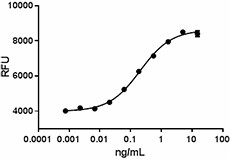- Regulatory Status
- RUO
- Other Names
- Megakaryocyte Colony Stimulating Factor (MKCSF), Myeloproliferative leukemia virus oncogene ligand (Mpl-ligand), Megakaryocyte growth and development factor (MGDF), THPO

-

Human TPO induces proliferation of MO7e megakaryocytic leukemia cells in a dose dependent manner with ED50 of 0.15 - 0.6 ng/mL.
| Cat # | Size | Price | Quantity Check Availability | ||
|---|---|---|---|---|---|
| 763702 | 10 µg | $218.00 | |||
| 763704 | 25 µg | $317.00 | |||
| 763706 | 100 µg | $996.00 | |||
TPO is a key regulator of megakaryocytopoiesis and thrombopoiesis. TPO binds to its receptor, the cellular homologue of the myeloproliferative leukemia virus oncogene (c-Mpl), and stimulates the proliferation and maturation of megakaryocytes. MPL does not possess kinase activity, thus the receptor associates with intracytoplasmic tyrosine kinases, janus kinase 2 (JAK2), for signal transduction. JAK2 is also important for MPL stability and cell-surface expression. TPO is able to promote the survival, self-renewal, and expansion of hematopoietic stem cells and primitive multi-lineage progenitor cells. TPO levels in blood and bone marrow are inversely related to platelet count. The regulation of TPO levels is mediated by its receptor c-Mpl (uptake and destruction). TPO is upregulated by PDGF and FGF-2, and it is downregulated by PF4, thrombospondin, and TGF-β in bone marrow stromal cells. In hepatocytes, HGF enhances TPO mRNA expression. During acute-phase response, IL-6 induces TPO transcription in the liver. Elevated plasma TPO levels exist in several hematological diseases associated with thrombocytopenia, coronary syndromes, and sepsis. Besides its hematopoietic effects, TPO is expressed in the brain where it promotes apoptosis of hypoxia sensitized neurons and inhibits neuronal differentiation by blocking NGF-induced signaling. Increased TPO concentrations are present in the cerebrospinal fluid of some patients with bacterial or viral meningitis.
Product Details
- Source
- Human TPO, (amino acids Ser22-Gly353, Accession # NM_000460) was expressed in 293E cells.
- Molecular Mass
- The 332 amino acid recombinant protein has a predicted molecular mass of approximately 35.5 kDa. The DTT-reduced and non-reduced proteins migrate at approximately 70 kDa by SDS-PAGE. The predicted N-terminal amino acid is Ser.
- Purity
- >95%, as determined by Coomassie stained SDS-PAGE.
- Formulation
- 0.22 µm filtered protein solution is in PBS, pH 7.2.
- Endotoxin Level
- Less than 0.1 EU per µg protein as determined by the LAL method.
- Concentration
- 10 and 25 µg sizes are bottled at 200 µg/mL. 100 µg size and larger sizes are lot-specific and bottled at the concentration indicated on the vial. To obtain lot-specific concentration and expiration, please enter the lot number in our Certificate of Analysis online tool.
- Storage & Handling
- Unopened vial can be stored between 2°C and 8°C for up to 2 weeks, at -20°C for up to six months, or at -70°C or colder until the expiration date. For maximum results, quick spin vial prior to opening. The protein can be aliquoted and stored at -20°C or colder. Stock solutions can also be prepared at 50 - 100 µg/mL in appropriate sterile buffer, carrier protein such as 0.2 - 1% BSA or HSA can be added when preparing the stock solution. Aliquots can be stored between 2°C and 8°C for up to one week and stored at -20°C or colder for up to 3 months. Avoid repeated freeze/thaw cycles.
- Activity
- ED50 = 0.15 - 0.6 ng/mL as measured by the ability of protein to induce proliferation of MO7e megakaryocytic leukemia cells. Deep Blue Cell Vialibity Kit was used to quantitate cell proliferation.
- Application
-
Bioassay
- Application Notes
-
BioLegend carrier-free recombinant proteins provided in liquid format are shipped on blue-ice. Our comparison testing data indicates that when handled and stored as recommended, the liquid format has equal or better stability and shelf-life compared to commercially available lyophilized proteins after reconstitution. Our liquid proteins are verified in-house to maintain activity after shipping on blue ice and are backed by our 100% satisfaction guarantee. If you have any concerns, contact us at tech@biolegend.com.
- Product Citations
-
Antigen Details
- Structure
- Growth Factor, homodimer
- Distribution
-
TPO is produced by the liver and kidney and is expressed in the central nervous system and bone marrow
- Function
- TPO regulates the megakaryocytopoiesis and thrombopoiesis
- Interaction
- Megakaryocytes, platelets, hemangioblasts, hematopoietic stem cells, and endothelial cells
- Ligand/Receptor
- c-Mpl
- Bioactivity
- Measured by its ability to induce proliferation of MO7e megakaryocytic leukemia cells
- Cell Type
- Mesenchymal Stem Cells, Hematopoietic stem and progenitors, Embryonic Stem Cells
- Biology Area
- Apoptosis/Tumor Suppressors/Cell Death, Cell Biology, Stem Cells
- Molecular Family
- Growth Factors, Cytokines/Chemokines
- Antigen References
-
1. Avanzi G, et al. 1988. Br. J. Haematol. 69:359.
2. Deutsch V.R. and Tomer A. 2006. Br. J. Haematol. 134:453.
3. Drachman JG, et al. 1995. J. Biol. Chem. 270:4979.
4. Li J. et al. 1999. Br. J. Haematol. 106:345.
5. Kato T, et al. 1997. Proc. Natl. Acad. Sci. 94:4669.
6. Ehrenreich H, et al. 2005. Proc. Natl. Acad. Sci. USA. 102:862.
7. Royer Y, et al. 2005. J. Biol. Chem. 280:27251.
8. Kaushansky K. 2005. J. Clin. Invest. 115:3339.
9. de Graaf CA and Metcalf D. 2011. Cell Cycle 10:1582.
10. Zhang J, et al. 2010. J. Interferon Cytokine Res. 7:465.
11. Lupia E, et al. 2012. Mediators Inflamm. 2012:390892.
12. Besancenot R, et al. 2014. Blood 124:2104. - Gene ID
- 7066 View all products for this Gene ID
- UniProt
- View information about TPO on UniProt.org
